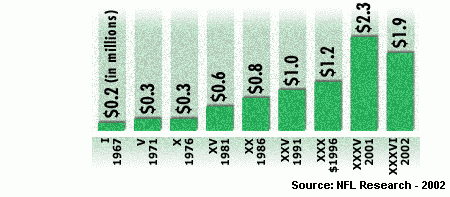Super Bowl Advertisements: A Super 30 Seconds
By: Jason Arcuri
The fact that the Super Bowl has been regarded as the "Advertising Olympics " should say a lot for the presence of ads (in the form of television commercials) within the game's broadcast. In fact, it also says a lot for an underlying theme of the game itself. For many observers, the Super Bowl is viewed as one of the best representations of North American capitalism in the modern society due to the fact that money plays a significant role in almost every aspect of the game. Essentially, there should be little debate surrounding the inclusion of advertising into this grouping.
Tied to television because
of its tremendous power and range as a medium, advertisements have
never deviated from their ultimate goal of addressing the highest
number of people in order to promote and  sell
the greatest amount of product. As it grew into an enormous cultural
phenomenon, it became obvious that the Super Bowl provided the ultimate
stage for these ads to be seen. However, it was not until the "1984"
ad from Apple Computers (which is widely considered to be the
greatest Super Bowl ad of all time) that ads began to garner
much attention, leading to the transformation of "the Super
Bowl from a football game to a showcase for Madison Avenue's best
work" (Horovitz, 2002).
From that point on, the broadcast of the Super Bowl would never
be the same.
sell
the greatest amount of product. As it grew into an enormous cultural
phenomenon, it became obvious that the Super Bowl provided the ultimate
stage for these ads to be seen. However, it was not until the "1984"
ad from Apple Computers (which is widely considered to be the
greatest Super Bowl ad of all time) that ads began to garner
much attention, leading to the transformation of "the Super
Bowl from a football game to a showcase for Madison Avenue's best
work" (Horovitz, 2002).
From that point on, the broadcast of the Super Bowl would never
be the same.
Like many other elements of the Super Bowl other than the game, these advertisements sought a share of its tremendous entertainment value. However, with numerous other elements vying for the same share, advertising needed to establish a different niche for itself. As seen through the history of Super Bowl commercials, the game provided the avenue for the advent of a new form of advertising, one which involved much more work, effort and creativity than ever before. No longer looking to simply sell a product, advertisers have begun to engage in an annual competition for nothing less than a place in pop culture history. All of this led to the creation of an entirely new advertising industry, one in which commercials were being produced as if they were miniature Hollywood movies. On top of this, with the cost of a 30-second spot escalating (reaching an all time high of $2.3 million in 2001 - Horovitz, 2002), these advertisers also sought huge returns. Needless to say, spending the equivalent of a small country's GDP in one day's worth of advertising would do that to many.
|
Cost of a 30-second
ad in Super Bowl History
|

Whether it has paid off
or not, these advertisers should be proud to know that their ads
have essentially become another reason why many of the Super Bowl's
"non-fans" tune in to watch the game. By reaching the
point in which they are covered and critiqued as if they were actual
movies, Super Bowl ads have developed an enormous following
which has made them as anticipated as the game itself.

|
Disclaimer © 2003 - 2004 by class of SOSC 4319 at York University |